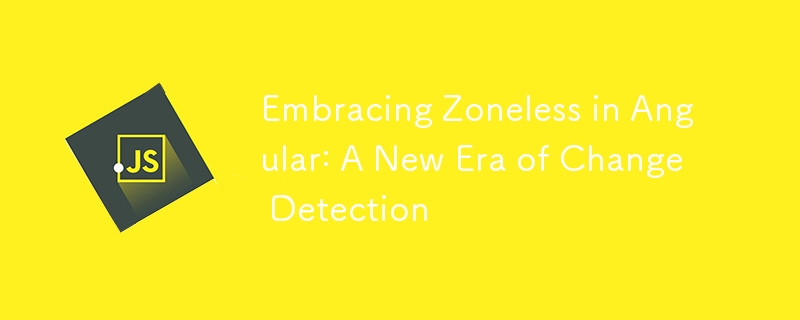Embracing Zoneless in Angular: A New Era of Change Detection
Jan 21, 2025 am 06:29 AM
Angular 18, released May 22, 2024, introduced an experimental game-changer: zoneless Angular applications. This eliminates the Zone.js dependency, boosting performance, reducing overhead, and simplifying debugging. Let's delve into zoneless applications, their advantages, and how to experiment with this feature.
Understanding Angular's Change Detection (Pre-Zoneless)
Change detection keeps the DOM synchronized with component data. Previously, Angular relied on Zone.js. Change detection triggered in these ways:
- User Interactions: Button clicks, text input.
-
Asynchronous Operations: HTTP requests,
setTimeout,setInterval, Promise resolutions. -
Manual Triggers:
ApplicationRef.tick(),ChangeDetectorRef.detectChanges().
Zone.js patched browser APIs, notifying Angular to initiate change detection. While effective, this added overhead and sometimes caused ExpressionChangedAfterItHasBeenCheckedError.
Change Detection Examples (Pre-Zoneless)
Before zoneless change detection, Zone.js managed UI updates. This StackBlitz example illustrates:
- Event Handler Property Update: A button click updates a counter. Zone.js intercepts, schedules change detection, and updates the UI.
- Asynchronous Property Update: An interval updates a property. Zone.js detects the asynchronous operation and updates the UI.
-
HTTP Data (Array): Data fetched via HTTP is stored in an array; Angular's default change detection updates the view. However, with
ChangeDetectionStrategy.OnPush, direct array mutations might not update the view unless the reference changes or change detection is manually triggered. -
HTTP Data (Async Pipe):
AsyncPipesimplifies observable handling, automatically subscribing and triggering change detection. - HTTP Data (Signal): Angular signals (a modern feature) directly notify dependent readers, streamlining updates independently of Zone.js.
These examples highlight Zone.js's role in change detection, setting the stage for Angular's improved zoneless architecture.
Why Choose Zoneless?
Removing Zone.js offers significant benefits:
-
Simplified Change Detection: Fewer
ExpressionChangedAfterItHasBeenCheckedErrorissues and zone-related complexities. - Reduced Overhead: A lighter framework, improving performance.
- Improved Debugging: Better change detection control, easier performance bottleneck identification.
Configuring a Zoneless Angular Application
Switching to zoneless requires configuration changes:
-
Enable Zoneless Change Detection: In
app.config.ts, add:
providers: [ provideExperimentalZonelessChangeDetection() ]
Remove provideZoneChangeDetection() if present.
- Remove Zone.js Imports:
- Delete
import '*zone.js';from your application files. - In
angular.json, removezone.jsfrom thepolyfillsarray:
"polyfills": []
- Uninstall Zone.js:
npm uninstall zone.js
Testing Change Detection Without Zone.js
This example demonstrates change detection without Zone.js:
Let's analyze each scenario:
Scenario 1: Event Handler Property Update
Works as expected.
Scenario 2: Asynchronous Property Update
Requires this.changeDetectorRef.markForCheck(); or using signals:
Corrected version (with markForCheck):
Corrected version (with signals):
Scenario 3: HTTP Data (Array)
The view doesn't update automatically:
Corrected version (with markForCheck):
Using async pipe is preferred.
Scenario 4: HTTP Data (Async Pipe)
Straightforward; use the async pipe:
Scenario 5: HTTP Data (Signal)
Use toSignal() to convert observables to signals:
Summary:
- Event Handlers: UI updates seamlessly.
- Asynchronous Operations: Requires
markForCheck()or signals. - HTTP (Observables): Use the
asyncpipe. - Signals: Automatic UI updates upon signal changes.
Angular 19 Update (November 19, 2025)
Angular 19 further refined zoneless application support, improving APIs, adding server-side rendering support, and enhancing testing. The Angular CLI now supports creating zoneless projects:
providers: [ provideExperimentalZonelessChangeDetection() ]
The above is the detailed content of Embracing Zoneless in Angular: A New Era of Change Detection. For more information, please follow other related articles on the PHP Chinese website!

Hot AI Tools

Undress AI Tool
Undress images for free

Undresser.AI Undress
AI-powered app for creating realistic nude photos

AI Clothes Remover
Online AI tool for removing clothes from photos.

Clothoff.io
AI clothes remover

Video Face Swap
Swap faces in any video effortlessly with our completely free AI face swap tool!

Hot Article

Hot Tools

Notepad++7.3.1
Easy-to-use and free code editor

SublimeText3 Chinese version
Chinese version, very easy to use

Zend Studio 13.0.1
Powerful PHP integrated development environment

Dreamweaver CS6
Visual web development tools

SublimeText3 Mac version
God-level code editing software (SublimeText3)

Hot Topics
 Java vs. JavaScript: Clearing Up the Confusion
Jun 20, 2025 am 12:27 AM
Java vs. JavaScript: Clearing Up the Confusion
Jun 20, 2025 am 12:27 AM
Java and JavaScript are different programming languages, each suitable for different application scenarios. Java is used for large enterprise and mobile application development, while JavaScript is mainly used for web page development.
 Mastering JavaScript Comments: A Comprehensive Guide
Jun 14, 2025 am 12:11 AM
Mastering JavaScript Comments: A Comprehensive Guide
Jun 14, 2025 am 12:11 AM
CommentsarecrucialinJavaScriptformaintainingclarityandfosteringcollaboration.1)Theyhelpindebugging,onboarding,andunderstandingcodeevolution.2)Usesingle-linecommentsforquickexplanationsandmulti-linecommentsfordetaileddescriptions.3)Bestpracticesinclud
 Javascript Comments: short explanation
Jun 19, 2025 am 12:40 AM
Javascript Comments: short explanation
Jun 19, 2025 am 12:40 AM
JavaScriptcommentsareessentialformaintaining,reading,andguidingcodeexecution.1)Single-linecommentsareusedforquickexplanations.2)Multi-linecommentsexplaincomplexlogicorprovidedetaileddocumentation.3)Inlinecommentsclarifyspecificpartsofcode.Bestpractic
 JavaScript Data Types: A Deep Dive
Jun 13, 2025 am 12:10 AM
JavaScript Data Types: A Deep Dive
Jun 13, 2025 am 12:10 AM
JavaScripthasseveralprimitivedatatypes:Number,String,Boolean,Undefined,Null,Symbol,andBigInt,andnon-primitivetypeslikeObjectandArray.Understandingtheseiscrucialforwritingefficient,bug-freecode:1)Numberusesa64-bitformat,leadingtofloating-pointissuesli
 JavaScript vs. Java: A Comprehensive Comparison for Developers
Jun 20, 2025 am 12:21 AM
JavaScript vs. Java: A Comprehensive Comparison for Developers
Jun 20, 2025 am 12:21 AM
JavaScriptispreferredforwebdevelopment,whileJavaisbetterforlarge-scalebackendsystemsandAndroidapps.1)JavaScriptexcelsincreatinginteractivewebexperienceswithitsdynamicnatureandDOMmanipulation.2)Javaoffersstrongtypingandobject-orientedfeatures,idealfor
 How to work with dates and times in js?
Jul 01, 2025 am 01:27 AM
How to work with dates and times in js?
Jul 01, 2025 am 01:27 AM
The following points should be noted when processing dates and time in JavaScript: 1. There are many ways to create Date objects. It is recommended to use ISO format strings to ensure compatibility; 2. Get and set time information can be obtained and set methods, and note that the month starts from 0; 3. Manually formatting dates requires strings, and third-party libraries can also be used; 4. It is recommended to use libraries that support time zones, such as Luxon. Mastering these key points can effectively avoid common mistakes.
 JavaScript: Exploring Data Types for Efficient Coding
Jun 20, 2025 am 12:46 AM
JavaScript: Exploring Data Types for Efficient Coding
Jun 20, 2025 am 12:46 AM
JavaScripthassevenfundamentaldatatypes:number,string,boolean,undefined,null,object,andsymbol.1)Numbersuseadouble-precisionformat,usefulforwidevaluerangesbutbecautiouswithfloating-pointarithmetic.2)Stringsareimmutable,useefficientconcatenationmethodsf
 Why should you place tags at the bottom of the ?
Jul 02, 2025 am 01:22 AM
Why should you place tags at the bottom of the ?
Jul 02, 2025 am 01:22 AM
PlacingtagsatthebottomofablogpostorwebpageservespracticalpurposesforSEO,userexperience,anddesign.1.IthelpswithSEObyallowingsearchenginestoaccesskeyword-relevanttagswithoutclutteringthemaincontent.2.Itimprovesuserexperiencebykeepingthefocusonthearticl






